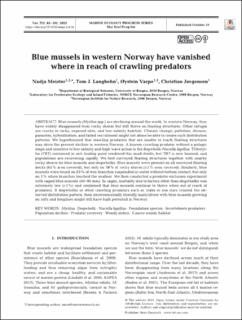| dc.contributor.author | Meister, Nadja | |
| dc.contributor.author | Langbehn, Tom | |
| dc.contributor.author | Varpe, Øystein | |
| dc.contributor.author | Jørgensen, Christian | |
| dc.coverage.spatial | western Norway | en_US |
| dc.date.accessioned | 2024-02-06T14:00:47Z | |
| dc.date.available | 2024-02-06T14:00:47Z | |
| dc.date.created | 2023-11-13T13:17:41Z | |
| dc.date.issued | 2023 | |
| dc.identifier.citation | Marine Ecology Progress Series. 2023, 721 85-101. | en_US |
| dc.identifier.issn | 0171-8630 | |
| dc.identifier.uri | https://hdl.handle.net/11250/3115987 | |
| dc.description.abstract | Blue mussels (Mytilus spp.) are declining around the world. In western Norway, they have widely disappeared from rocky shores but still thrive on floating structures. Other refugia are cracks in rocks, exposed sites, and low-salinity habitats. Climate change, pollution, disease, parasites, hybridization, and failed recruitment might not alone be able to create such distribution patterns. We hypothesized that crawling predators that are unable to reach floating structures may drive the present decline in western Norway. A known crawling predator without a pelagic stage and sensitive to low salinity and high wave action is the dogwhelk Nucella lapillus. Tributyltin (TBT) contained in anti-fouling paint rendered this snail sterile, but TBT is now banned, and populations are recovering rapidly. We first surveyed floating structures together with nearby rocky shores for blue mussels and dogwhelks. Blue mussels were present on all surveyed floating docks (65% area covered), but only on 18% of rocky shores (≤5% area covered). Similarly, blue mussels were found on 83% of tree branches suspended in water without bottom contact, but only on 1% when branches touched the seafloor. We then conducted a predator exclusion experiment with caged blue mussels (40-80 mm). In cages, mortality due to factors other than dogwhelks was extremely low (<1%) and confirmed that blue mussels continue to thrive when out of reach of predators. If dogwhelks or other crawling predators such as crabs or sea stars created the observed distribution pattern, then environmentally friendly mariculture with blue mussels growing on rafts and longlines might still have high potential in Norway. ytilus · Dogwhelk · Nucella lapillus · Foundation species · Invertebrate predators · Population decline · Predator recovery · Woody debris · Coarse woody habitat | en_US |
| dc.description.abstract | Blue mussels in western Norway have vanished where in reach of crawling predators | en_US |
| dc.language.iso | eng | en_US |
| dc.rights | Navngivelse 4.0 Internasjonal | * |
| dc.rights.uri | http://creativecommons.org/licenses/by/4.0/deed.no | * |
| dc.subject | Blåskjell | en_US |
| dc.subject | Blue mussels | en_US |
| dc.subject | Predator | en_US |
| dc.subject | Predator | en_US |
| dc.title | Blue mussels in western Norway have vanished where in reach of crawling predators | en_US |
| dc.title.alternative | Blue mussels in western Norway have vanished where in reach of crawling predators | en_US |
| dc.type | Peer reviewed | en_US |
| dc.type | Journal article | en_US |
| dc.description.version | publishedVersion | en_US |
| dc.subject.nsi | VDP::Geofag: 450 | en_US |
| dc.subject.nsi | VDP::Geosciences: 450 | en_US |
| dc.subject.nsi | VDP::Matematikk og Naturvitenskap: 400::Zoologiske og botaniske fag: 480::Marinbiologi: 497 | en_US |
| dc.source.pagenumber | 85-101 | en_US |
| dc.source.volume | 721 | en_US |
| dc.source.journal | Marine Ecology Progress Series | en_US |
| dc.identifier.doi | 10.3354/meps14416 | |
| dc.identifier.cristin | 2195807 | |
| cristin.ispublished | true | |
| cristin.fulltext | original | |
| cristin.qualitycode | 2 | |

